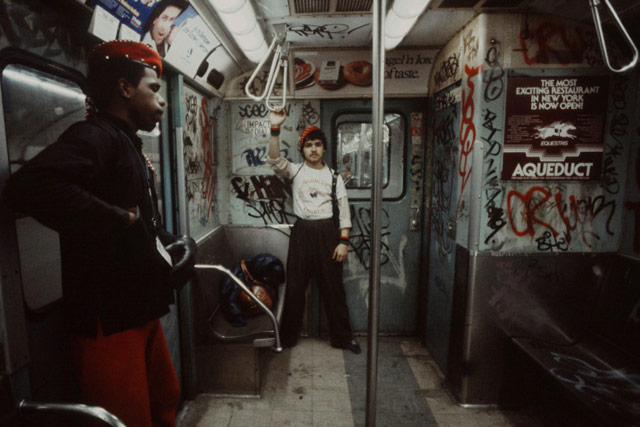You may have heard about content marketing, but how much do you know about context marketing? Read on to discover how you can harness context in your marketing materials…
Context shapes our decisions, and attitudes and allows us to understand everything that surrounds a focal event.
Why then, is its power to influence undervalued in marketing?
As an industry dependent on analytics, split-tests and percentile improvements, our focus can easily shift from the big picture to microscopic targets.
There is value in doing this, especially when you understand the difference a 1% increase in conversion rates can have on your ROI…
…but, when context is applied correctly (as an overarching strategy) it can have incredible effects on every aspect of your business.
To help me explain, I’ll need to enlist the help of one broken window.
Contents
The Broken Window Theory

The broken window theory will be new to many of you. As entrepreneurs, business people and students of marketing, you can be excused for never having heard of this criminological theory.
In a moment, I will clarify exactly how it relates to marketing, but before we get there, let’s dive into one of my favourite psychological studies (any regular readers will know how much I love psychology).
Way back in March 1982, James Q. Wilson and George L. Kelling published an article entitled ‘Broken Windows’ in The Atlantic Monthly.
The title and main drive behind their theory came from this particular excerpt:
Consider a building with a few broken windows. If the windows are not repaired, the tendency is for vandals to break a few more windows. Eventually, they may even break into the building, and if it’s unoccupied, perhaps become squatters or light fires inside.
Or consider a pavement. Some litter accumulates. Soon, more litter accumulates. Eventually, people even start leaving bags of refuse from take-out restaurants there or even break into cars.
This is a quick summary of an article that goes into depth about how minor contextual changes can have huge implications on crime rates.
The broken window theory explains that petty offences (such as littering, graffiti and anti-social behaviour) can spiral into a contextual feeling of lawlessness, which in turn, creates increases in larger crimes (e.g. theft, burglary and assault).
This theory can be transferred and applied anywhere that context affects behaviour, decision making and influence.
For example, do you act the same way in an expensive restaurant as a fast food joint?
The Power of Context

The broken window theory might sound reasonable on paper, but it’s actually been proven to work in practice too.
One of the best examples is the ‘clean car program’ introduced to the New York subway system in 1984. Before this overhaul, crime was a huge issue on the subway and had grown year after year.
The President of the New York Transit Authority, David L. Gunn, decided that the best way to tackle the problem was to change the entire subway environment. At this time, many of the subway cars (or carriages, if you’re English) were completely covered in graffiti.

Gunn’s plan was to eradicate the graffiti in the hope that it would have an effect on the behaviour of passengers. This involved cleaning all graffitied subway cars (a massive task at the time) and then immediately cleaning off graffiti when it was painted on again.
This contextual change made a huge difference to crime rates on trains and Gunn is credited with turning around the New York subway system in the mid to late 80s (by The New York Times).
The broken window theory was also used in Albuquerque, Lowell, the Netherlands and again in New York, with successful reports in each case.
That’s Great, But How Does it Apply to Marketing?

The broken window theory explains the power of context from a perspective of crime prevention…
…but what if we flip the theory in our favour?
This means looking at the power of context, not as something we should maintain and police, but as something we should promote and use to encourage positivity.
People often see themselves as independent thinkers, but the truth is, we are all very heavily affected by the world around us and particularly, the context of our circumstances.
As marketers, it’s our job to promote the correct context at the correct time, so our prospects are encouraged to take our desired action.
The great thing for us is, that within the digital world, we can easily create our own context. We don’t have to worry about external factors, like those listed in the broken window theory.
And we can use context to promote our brand (in the manner we’d like), create beneficial trends and influence our prospect’s decisions.
This means pulling your focus from the micro-details (like copy, image, UX) and analysing your brand and the context that surrounds it, as a big picture.
From this birds-eye view, you can make decisions that will affect and align all of your micro-details, so they pull towards the same contextual effect.
If something as simple as keeping litter off the streets or cleaning graffiti off a subway car can prevent criminality, why can’t a few simple shifts in the context of your brand boost awareness, improve conversions and increase your marketing ROI?
How Can You Affect Context?

When it comes to context, the small stuff makes a massive difference. This is why it’s so important to look at the context of your online presence as an over-arching strategy and work down, checking that all of the small moving parts align.
Everything must tie together for context to work. Remember, just one broken window can ruin everything.
Before we get into the tips and tricks of building brand context, let’s look at the two types of environments you’ll need to strategise for:
- Environments you control: these are places that you have 100% command over context, including your website, social media content, products and communications.
- Environments you affect: whilst you can’t control the entire environment, you must ensure your brand fits and compliments the context of your positioning, these include, ad placements, newsfeeds, distribution spots, prospect’s environment, and marketing channels.
When you have a clear understanding of your brand strategy and message (from a broad viewpoint), you must ensure that the ‘environments you control’ align with those that you only affect.
If you are positioning your brand in a place that doesn’t fit with your context strategy, you are effectively weakening its power. Focus your efforts on the places that WILL have a positive effect on your business.
Context Tactics
Context should be used to ensure that your business is easily understood, immediately makes sense in the eyes of your prospects and encourages action (e.g. purchase decisions, social follows, conversations).
There are hundreds of different ways to influence context. To get you started, I’ve rounded up a few of my favourites:
Customer Understanding

Whilst this might not be a tactic you can implement, it will drive a lot of your key decisions.
The better you understand your customer, the more you are able to influence your brand’s context in a positive light.
Knowing everything about your ideal customer will allow you to build a clear picture of their day, their loves, hates, hobbies, home life and the context that surrounds them. When you know this, you can have positive influence on their decisions.
The best way to understand your ideal customer is by building a Customer Avatar. Use our guide and template to get started!
Trust, Authority, Expertise, Customer Focus

I’ve rolled these four factors into one point because despite them being separate entities, they are all very closely linked in the digital environments you control.
It’s absolutely integral (especially if you’re selling online) that you build a buying environment users can trust, that they see as an authority in the industry, and demonstrates expertise and customer focus.
If you’re stuck for ideas, here are a few tactics that will help you achieve these aims:
- Customer reviews/testimonials: positive reviews build trust and demonstrate customer care
- Problem-solving content: build your authority and demonstrate your expertise by helping prospects solve their problems with quality content (e.g. blog, video, podcast)
- Awards: if you’ve won awards, show them off where possible. This will positively contribute to all four factors (above).
- Build a social following: a large social following creates social proof, proving expertise, authority and trust.
- Site security: ensure your site is secure. Make sure you have the necessary SSL certificates and you are running on HTTPS not HTTP.
Conversations/Interactions

A great way to affect your brand’s context is by maximising interactions with your prospects.
This means using every available opportunity to turn comments into conversations, reviews into discussions and enquiries into context delivering chats.
Amongst the best places to spark up extended digital interactions are social media posts, direct messages and emails. The trick to this is asking open questions that encourage responses (longer than one word), especially when you think the conversation might be dead!
The more you can interact with your prospects (in line with your brand) the more you’re able to influence the context of their decisions and their opinion of your brand.
Provide Massive Value (Overdeliver)

No matter what industry your business operates in or what kind of positive context you’re trying to promote, providing massive value will always reap big rewards.
The key to this is overdelivering on your promises. This can mean providing extra value in your content, entertaining (via your social channels, e.g. viral content) or adding something extra to their purchases (this is particularly powerful when it’s a surprise).
Overdelivering creates referrals, drives repeat buyers and inspires an incredibly positive context around your brand.
Voice

Whether you’re writing copy, content or directly contacting prospects/customers, you’ll need to carefully consider the type of voice you’d like to represent your brand and its effect on the context that surrounds you.
Whatever you decide, make sure that you are consistent across all channels and that you have your ideal customer in mind when formulating a brand voice.
Conclusion
Context marketing is often overlooked.
It’s not something that can be implemented in small parts, as just the tiniest error can make all the difference (look at the broken window theory).
If you’d like to influence decision-making, attitude and the way your brand is perceived, context is the perfect place to start.
Think about the type of context marketing you’d like your brand to be seen in, audit your business as a whole and be consistent with your changes.
If you’d like to create the perfect context for your customer, I recommend building a Customer Avatar so you can understand everything about them!
- Author Details




